In a game where the Irish needed to lean on the run, Dexter Williams and the offensive line came through with a season-high 8.14 yards per carry (excluding garbage time) against a solid FSU front. The Noles entered the game ranked 33rd in Rushing Defense S&P+, including the 26th best run stuff rate. But the Irish were pretty efficient and extremely explosive on the ground, and were stuffed for no gain just twice with no tackles for a loss.
Confused? Check out the advanced stats glossary here or holler at me in the comments. In this game, garbage time began with Notre Dame’s final touchdown in the 4th quarter.
Efficiency
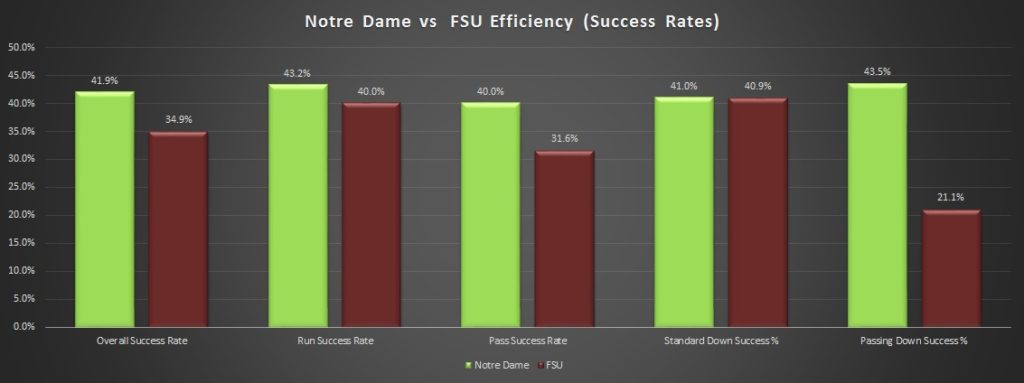
The Irish had a health efficiency edge in the 42-13 win, and while it wasn’t the dominant edge I thought it could be (at least until Ian Book’s injury), it’s a testament to solid game plan by the coaching staff that it led to an easy win. Florida State had been woeful on offense, especially running the ball, and Clark Lea responded by taking away the big-play threat of Florida State’s receivers. The trade-off was decent run success for FSU, but per usual the defense successfully executed a “bend but don’t break” approach. Notre Dame knew this offense wasn’t capable of stringing together enough long drives to win, and once they forced passing downs the Irish suffocated Deondre Francois and Taggart’s offense.
An average success rate passing the ball was a win for Brandon Wimbush, especially with a hot start that included successes on 9 of his first 16 pass attempts. Chip Long allowed Wimbush to throw some early passes that likely opened up the box a bit for the run later in the game. The passing offense finished with 5.2 pass yards per attempt – by comparison, the lowest mark under Book was 6.63 yards against Pitt. But it hardly mattered, as Wimbush took advantage of great scoring opportunities provided by the defense and led the ND offense to scores on each of their first five drives.

As mentioned in the introduction, the biggest revelation on this Senior Day was the running game, in particular the offensive line. A week ago I advocated for some movement towards a more pass-heavy attack (pre-Book injury). This was coming off the heels of a game where the Irish mustered just 3.59 yards per carry and were stuffed on nearly 30% of their runs against a solid and well-coached but not spectacularly talented Northwestern front. The previous contest against a power five opponent had similar results, with just 3.74 yards per carry against a so-so Pitt defense.
So to see the offensive line control a talented Seminole front – not allowing a single tackle for a loss – was extremely heartening. Dexter Williams was exceptional, showcasing his usual explosiveness but also finishing every short and medium run battling for extra yards. It wasn’t a perfect effort – stud DE Brian Burns was disruptive despite not making a tackle for a loss – but the revamped offensive line looked as good as it has all season.
Explosiveness
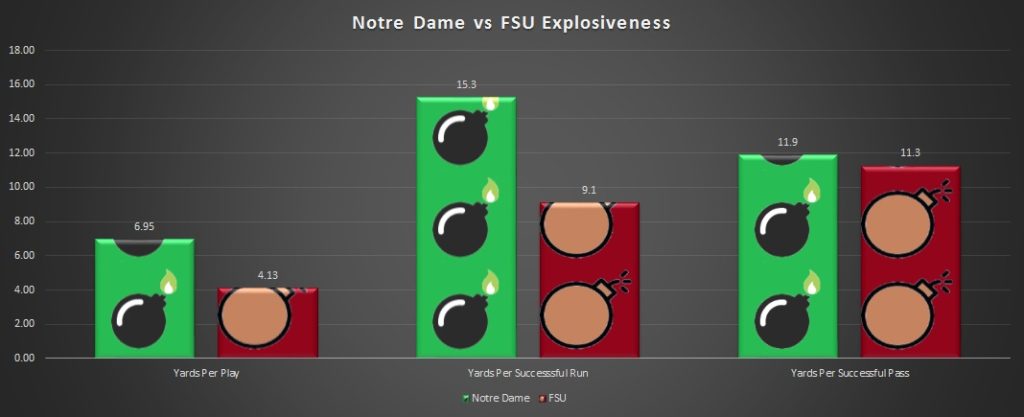
Notre Dame dominated the Seminoles in yards per play, with a +2.82 margin, the third highest this season behind Wake Forest (+4.17) and Northwestern (+3.07). Complementing the efficiency advantage was a strong advantage in rush explosiveness, with the Irish breaking four runs of over 22 yards, highlighted by Williams’ 58-yard TD. Pass explosiveness was essentially a draw, which counts as a win for Notre Dame, as that was the only realistic route to a Seminole upset. Francois connected with one long pass, a perfect 40-yard throw to Nyqwan Murray, that was about a 9.9 out of 10 in terms of degree of difficulty.
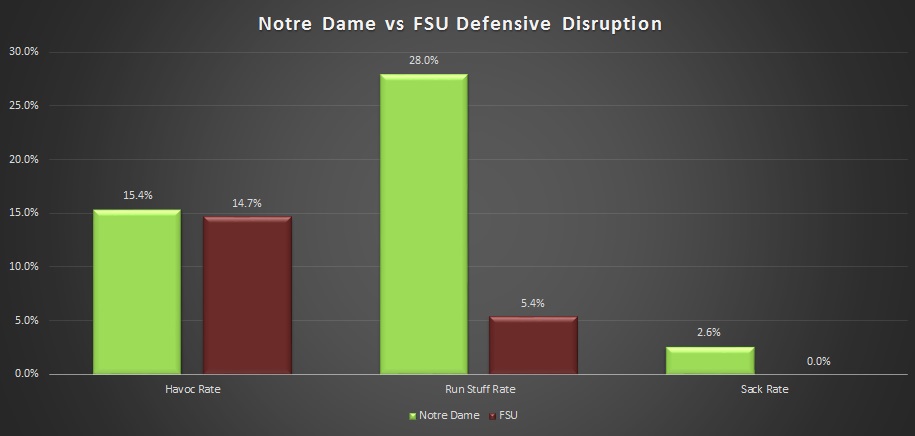
The Irish had a slight advantage in havoc rate, including the third straight game with no sacks allowed. While the Seminoles had better success running than expected, the Notre Dame front seven still put up an impressive stuff rate of 28%, a well above average number. How did FSU cause this much havoc without a TFL or sack? Florida State got their hands on 11 of Brandon Wimbush’s pass attempts – nine pass break-ups and two interceptions.
Finishing Drives, Field Position, & Turnovers
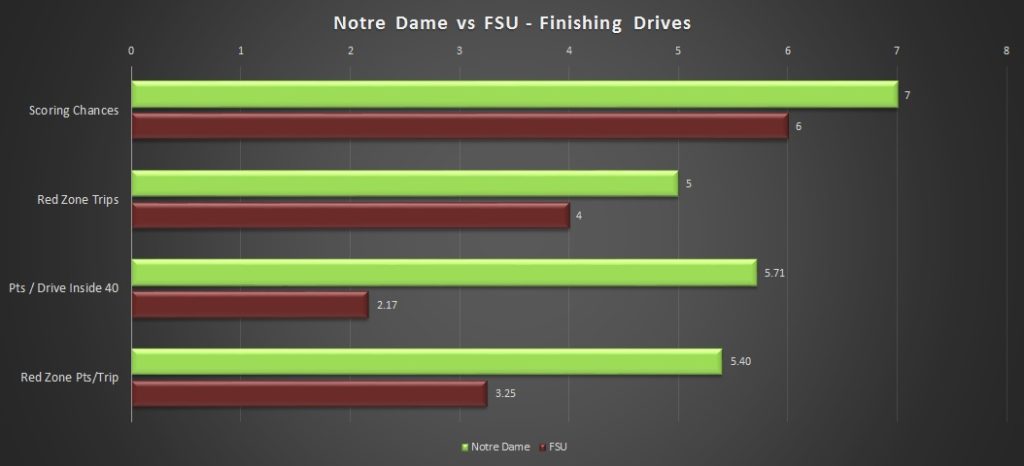
Bill Connelly’s recap included the fun fact that scoring opportunities in this game were about even! That tells part of the story – the Seminoles offense coming away empty on four trips inside the Irish 40 definitely contributed to the margin of victory. But it also ignores that the Irish were already up 17 points before the Noles had a single scoring chance, and three FSU scoring chances came in the last 16 minutes of the game that were either garbage time or close to it.
Either way, the Irish defense again excelled in limiting opponent scoring chances, and remain a top-10 unit in the category. It was incredibly satisfying that even when the Noles got on the board after starting down 17, that touchdown only narrowed the scoring margin by four points.
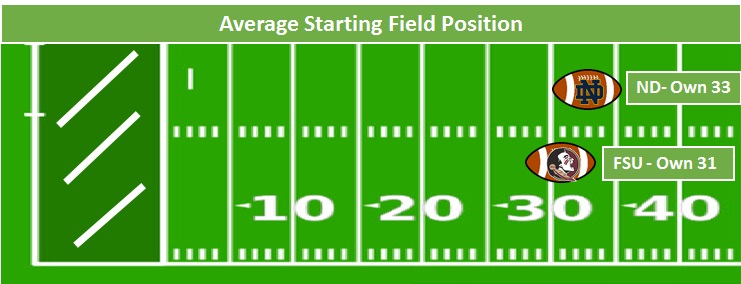
The Irish held a slight edge in the field position, but the damage was all done in the first few drives. The Notre Dame offense started two of their first three drives in the red zone thanks to the two early FSU turnovers. Tyler Newsome punted just once in each half, and the Seminoles made up some of that early field position disadvantage on the two second half Wimbush picks.
The turnover battle ended up tied, but the consequences of the underdogs quickly digging themselves a 17-0 hole far outweighed the interceptions they gained once the Irish had a comfortable lead. The early interception by Nick Coleman, who showed the potential to emerge (again!) as a steadying force at nickel back, seemed to dictate how this game would play out in the opening minute. Throw in the Ogundeji forced fumble and Notre Dame was up three scores before the chilly Seminoles had a single successful play.

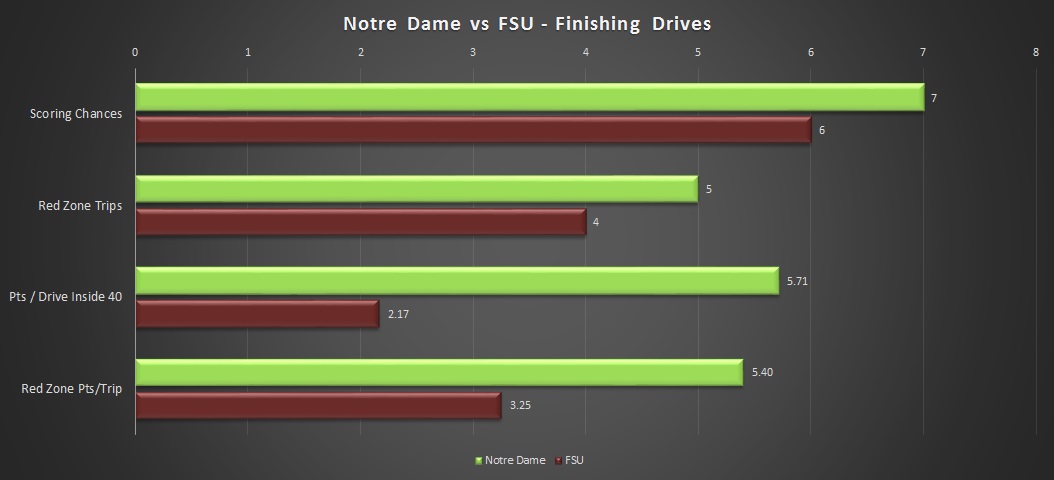



8.14 YPC against Florida State EXCLUDING GARBAGE TIME = hide the sweatpants in the Murtaugh home.
Welp.
Oh no… is it too late?!
You know how I know it’s Standard Time now? Because #18SAfterDark starts early.